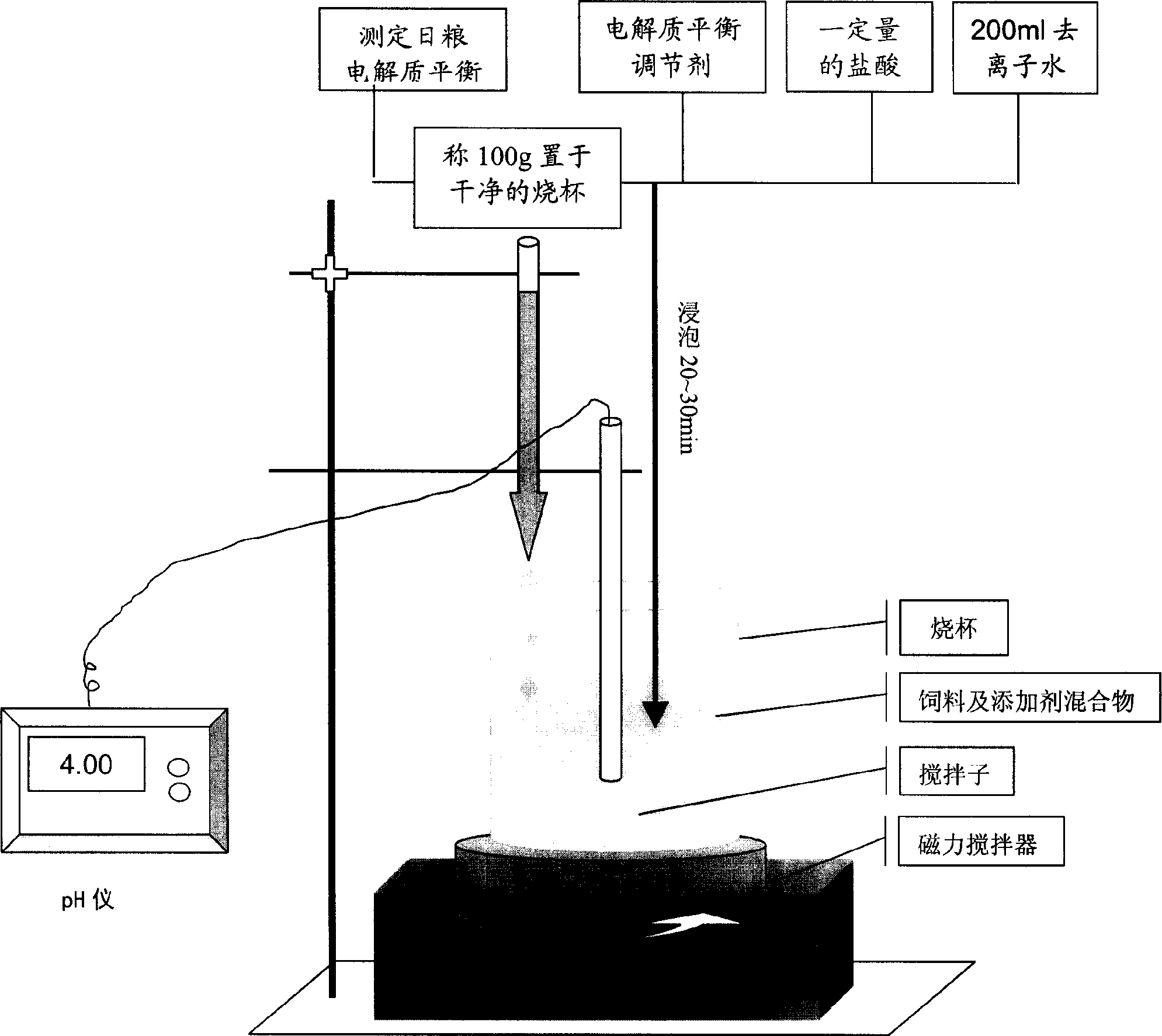Coupling regulation and control method for dietary acidity and electrolyte balance of piglet feedstuff
An electrolyte balance, piglet technology, applied in chemical analysis by titration, animal feed, etc., can solve problems such as affecting electrolyte balance, affecting animal growth potential, affecting dietary acidity and acid-base balance, etc., to improve acid-base balance, Avoid blindness effects
- Summary
- Abstract
- Description
- Claims
- Application Information
AI Technical Summary
Problems solved by technology
Method used
Image
Examples
Embodiment 1
[0024] Example 1, such as figure 1 shown.
[0025] (1) Grind the ration to be tested in a high-speed universal grinder at 24,000 rpm / min for 40 seconds, and then measure the K of the ration to be adjusted. + 、Na + and Cl - The concentrations are: 0.12%, 0.68%, 0.40%, according to dEB=K + +Na + -Cl - Calculate the electrolyte balance value of the diet: 113.48mEq / kg;
[0026] (2) Weigh 100 g of the above-mentioned piglet diet and place it in a clean beaker, add 2.13 g of sodium dihydrogen phosphate to adjust the electrolyte balance of the diet to the optimum value (assuming that the optimum value of the electrolyte balance is 250mEq / kg);
[0027] (3) Add 200ml deionized water;
[0028] (4) Adding 25mmol of hydrochloric acid adjusts its acidity to an optimal value (assuming that the optimal value of the acidity is 25);
[0029] (5) Stir evenly, soak for about half an hour (20-30min);
[0030] (6) Slowly titrate with 10% phosphoric acid, and the titration end point is pH=...
Embodiment 2
[0034] (1) Measure the K of the diet to be adjusted + 、Na + and Cl - The concentrations are: 0.12%, 0.68%, 0.40%, according to dEB=K + +Na + -Cl - Calculate the electrolyte balance value of the diet: 113.48mEq / kg;
[0035] (2) Weigh 100g of the above-mentioned piglet diet and place it in a clean beaker, add 1.15g of sodium bicarbonate to adjust the electrolyte balance of the diet to the optimum value (the optimum value of the electrolyte balance is 250mEq / kg);
[0036] (3) Add 200ml deionized water;
[0037] (4) Adding 25mmol of hydrochloric acid adjusts its acidity to an optimal value (assuming that the optimal value of the acidity is 25);
[0038] (5) Stir evenly, soak for about half an hour (20-30min);
[0039] (6) Slowly titrate with 10% citric acid, the titration end point is pH=4.00;
[0040] (7) The amount of acid consumed is 33ml, that is, the amount needed to regulate the acidity of the diet is 3.3%.
[0041] After adjustment, it was found that adding 3.3% ci...
Embodiment 3
[0043] (1) Measure the K of the diet to be adjusted + 、Na + and Cl - The concentrations are: 0.78%, 0.43%, 0.51%, according to dEB=K + +Na + -Cl - Calculate the electrolyte balance value of this diet: 243mEq / kg;
[0044] (2) Weigh 100g of the above-mentioned piglet ration and place it in a clean beaker, add 0.559g of trisodium citrate to adjust the electrolyte balance of the ration to the optimum value (the optimum value of the electrolyte balance is 300mEq / kg);
[0045] (3) Add 200ml deionized water;
[0046] (4) Adding 20mmol of hydrochloric acid adjusts its acidity to an optimal value (assuming that the optimal value of the acidity is 20);
[0047] (5) Stir evenly, soak for about half an hour (20-30min);
[0048] (6) Titrate slowly with 10% compound acid (phosphoric acid: citric acid: formic acid=3:4:3), and the titration end point is pH=4.00;
[0049] (7) The amount of acid consumed is 7ml, that is, the amount needed to control the acidity of the diet is 2.37%.
[0...
PUM
 Login to View More
Login to View More Abstract
Description
Claims
Application Information
 Login to View More
Login to View More - R&D
- Intellectual Property
- Life Sciences
- Materials
- Tech Scout
- Unparalleled Data Quality
- Higher Quality Content
- 60% Fewer Hallucinations
Browse by: Latest US Patents, China's latest patents, Technical Efficacy Thesaurus, Application Domain, Technology Topic, Popular Technical Reports.
© 2025 PatSnap. All rights reserved.Legal|Privacy policy|Modern Slavery Act Transparency Statement|Sitemap|About US| Contact US: help@patsnap.com

